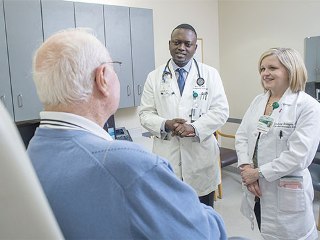Nov 2 2015
There is a debate about when the first successful open-heart surgery was performed in the United States. Some believe it was 122 years ago in Chicago when surgeon Daniel Hale Williams performed the momentous medical advancement.
 Oluseun Alli, M.D., director of the structural heart program, and Lindsay Jernigan, valve program coordinator and nurse practitioner, are among the caregivers patients encounter as part of UAB's multidisciplinary approach to treating valve disease. Credit: UAB News
Oluseun Alli, M.D., director of the structural heart program, and Lindsay Jernigan, valve program coordinator and nurse practitioner, are among the caregivers patients encounter as part of UAB's multidisciplinary approach to treating valve disease. Credit: UAB News
The other one that lays claim to being the first was performed in Montgomery in 1902 by Luther Leonidas Hill, when he sutured a stab wound in a young boy’s heart.
Physicians and researchers have spent the years since these feats tweaking and perfecting this remarkable idea of opening a chest to perform surgery on heart valves, muscles, arteries, the aorta and other parts of the organ — a process that continues to this day.
The University of Alabama at Birmingham’s Heart and Vascular Services structural heart disease program has been on the leading edge of advances in procedures that do not require a surgeon to open the chest for some treatments. With the first and largest comprehensive heart valve program in the state, UAB Medicine provides continuing care for patients who have or are at risk for valve disease.
Some of the nation’s most highly regarded physicians provide every UAB valve patient a host of diagnosis and treatment options. From aortic stenosis to mitral valve regurgitation, and from traditional open-heart surgery to the latest in minimally invasive procedures and robotic-assisted valve repair surgery, UAB, the School of Medicine and its patients benefit from nationally recognized experts in treating patients with valve disease.
The UAB Heart Valve Program has built an impressive list of accomplishments in recent years with cardiologists and heart surgeons performing the first transcatheter aortic valve replacement in Alabama; to date, more than 300 patients have benefited from the innovative, minimally invasive TAVR procedure. Physicians also recently implanted the Southeast region’s first Sapien 3 Transcatheter Heart Valve in a patient with aortic valve stenosis. This feat will enable more patients to have the procedure transfemorally through the groin.
“We have a structural team that is very experienced, has performed a lot of cases, and always aims to bring the most recent advances in heart care here to the people of our state and region,” said Oluseun Alli, M.D., director of the structural heart program. “We have the ability to do any procedure that is done anywhere else in the country. We have good imaging resources, and we have good outcomes — outcomes that are better than the national average.”
Because many procedures — including TAVR and transcatheter mitral valve interventions — can be performed minimally invasively, it greatly reduces the potential for bad outcomes, lessens the amount of time in the hospital after these procedures and opens up opportunities for patients of advanced ages to receive the highest-quality care.
“UAB has a multidisciplinary approach to treating heart valve disease,” Alli said. “When a patient is sent here to the valve program, they are evaluated by a group, and we work together to look for the best option for each individual patient. As technology advances, there are going to be more opportunities for treatment, and we intend to stay at the forefront of care to continue to serve our patients.”
UAB physicians evaluate patients referred to the structural heart disease program to see if they are best suited for myriad treatments beyond TAVR, including the transcatheter MitraClip device, mitral valve replacement, transcatheter valve-in-valve repair, perileak closure, valvuloplasty and other structural heart procedures. These procedures can be performed on people even of advanced age using these minimally invasive techniques. In many cases, patients leave the hospital within three days of having these procedures.
“Open-heart surgery is still very necessary and the best option for treatment in some cases,” said Massoud Leesar, M.D. “What we can offer patients, however, is a wealth of knowledge and expertise from a dedicated team of structural heart physicians to determine the best way to treat their valve disease. If it’s open-heart surgery, that’s what we recommend. If it’s a TAVR procedure, we will recommend that. We’ve performed lots of cases and can do any procedure offered anywhere else in the country, and we have established a track record for performing these procedures with outcomes above the national average.”
UAB’s structural heart program is the largest and most comprehensive in Alabama, and has treated patients from Alabama, Florida, Georgia and Mississippi. As an added service, patients who have been told by non-UAB doctors that they need valve surgery can speak to a UAB valve surgeon for a second opinion.